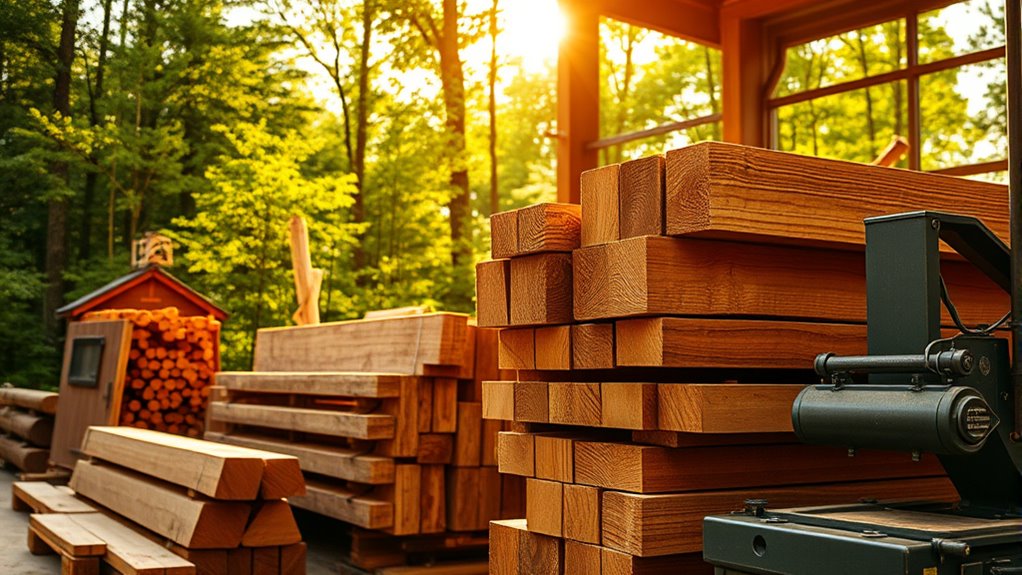Choosing wooden products benefits the environment because they store carbon during their lifespan, reducing greenhouse gases. They require less energy to produce compared to other materials, especially when manufacturing involves renewable energy and efficient processes. Wooden items are biodegradable and recyclable, returning nutrients to soil without toxic emissions. Plus, sustainably harvested wood supports healthy forests and biodiversity. If you want to discover how wooden products can make a real difference, keep exploring these eco-friendly advantages.
Key Takeaways
- Wooden products sequester and store carbon, reducing atmospheric CO2 and helping mitigate climate change.
- Sustainable forestry practices ensure responsible harvesting, maintaining forest health and biodiversity.
- Wood requires less energy to produce and process, lowering greenhouse gas emissions compared to other materials.
- Wooden items are biodegradable and recyclable, minimizing waste and environmental pollution.
- Durability and longevity of wood reduce the need for frequent replacements, conserving resources over time.
The Role of Trees in Combating Climate Change

Trees play a crucial role in fighting climate change by actively removing carbon dioxide from the atmosphere through photosynthesis. As you observe, trees absorb CO2 and convert it into sugars, which fuels their growth. This process releases oxygen, helping to counteract human emissions. A single mature tree can remove about half a metric ton of CO2 annually, making forests the largest land-based carbon sink on Earth. In the U.S., forests offset roughly 16% of greenhouse gases, equivalent to decades of vehicle and power plant emissions. Trees also store carbon in their wood, locking it away for centuries, especially in older trees. By sequestering carbon, trees reduce atmospheric CO2 levels and contribute considerably to climate change mitigation efforts. Forests in the U.S. help offset a significant portion of the country’s emissions, highlighting the importance of preserving natural carbon sinks. Protecting these natural ecosystems is essential for maintaining their long-term ability to absorb CO2 and support biodiversity.
Sustainability and Responsible Forest Management

Sustainable forest management guarantees that wood and other forest products are harvested responsibly while maintaining the health and vigor of forest ecosystems. You benefit from practices that protect air quality, biodiversity, and soil stability, while also reducing flood risks and sequestering carbon. These methods balance ecological, economic, and social needs, ensuring forests remain productive and healthy. Managed forests include protected areas to preserve habitats and cultural sites, and operations mimic natural disturbances through selective harvesting. This approach supports local communities by creating jobs, boosting incomes, and respecting Indigenous rights. Certification systems like FSC and PEFC verify responsible practices, giving you confidence that the wood you choose comes from sustainable sources. Implementing sustainable harvesting methods can further minimize environmental impact and promote long-term forest health. Responsible forest management ensures forests continue to provide environmental, social, and economic benefits for generations and helps preserve biodiversity hotspots that are vital for global ecological balance. Additionally, integrating innovative monitoring technologies can improve the oversight and effectiveness of sustainable practices. Moreover, adopting forest certification programs encourages continuous improvement and accountability across the industry.
Energy Savings in Wood Product Manufacturing

Have you ever wondered how wood product manufacturing manages to reduce its energy consumption? It’s because it requires less heat than many industries, making it more energy-efficient. Lower heat needs mean the sector can adopt electrification, cutting reliance on fossil fuels and reducing greenhouse emissions. Optimized kiln drying also consumes less energy, further lowering environmental impact. Industry-wide, energy-efficient measures like cogeneration systems capture waste heat for reuse, while upgraded motors and repaired air leaks save significant power. Digital automation improves process control, reducing waste and energy use per unit. Additionally, waste heat recovery and renewable fuels diversify energy sources and cut dependency on fossil fuels. Implementing geothermal heat pump technology in manufacturing facilities can further enhance energy efficiency and sustainability, leveraging Earth’s stable heat for process heating and cooling. Moreover, adopting analytical cookies can help monitor and optimize energy consumption patterns across manufacturing processes. These energy management systems enable smarter control over energy use, leading to further reductions in waste. Incorporating innovative energy management systems can lead to smarter energy use and further environmental benefits. These innovations are supported by the growing understanding that sustainable practices are essential for long-term industry viability. All these innovations help the industry grow sustainably, lower costs, and stay competitive while supporting environmental goals.
Waste Reduction and the Benefits of Reclaimed Wood

Reclaimed wood plays a vital role in reducing industrial waste by repurposing materials from demolished or abandoned structures rather than discarding them. By reusing old lumber, you divert timber from landfills and cut down on waste generated during construction and renovation projects. This process requires less energy than producing new wood, reducing industrial emissions. Salvaging wood from existing buildings also minimizes the amount of raw timber discarded, helping to lower overall solid waste. Environmentally, using reclaimed wood limits the need for new tree harvesting, protecting forests and biodiversity. It supports sustainable forestry by decreasing demand for fresh timber, which slows deforestation. Plus, sourcing locally reduces transportation emissions, further shrinking your carbon footprint. Choosing reclaimed wood promotes recycling and fosters a culture of sustainability. Additionally, efficient recycling practices help conserve natural resources and promote a circular economy.
Durability, Biodegradability, and Environmental Compatibility

Wooden products stand out for their impressive durability, often lasting for decades and even centuries when properly maintained. They help keep buildings structurally sound over time without releasing harmful degradation products. This longevity also reduces the need for frequent replacements, which in turn minimizes waste and resource consumption. Thanks to advanced technology and sustainable forestry practices, wood is harvested responsibly, ensuring quality and ecosystem health. This sustainable approach supports environmental conservation and maintains biodiversity. This durability means fewer replacements and repairs, reducing resource consumption. Wood naturally biodegrades under suitable conditions, returning nutrients to the soil without toxic emissions. Unlike plastics or metals, it doesn’t require energy-intensive recycling processes. Additionally, trees absorb carbon dioxide, and wood products lock in this carbon throughout their lifespan, helping fight climate change. The natural properties of wood also contribute to air quality by avoiding the release of harmful chemicals during degradation. Moreover, wood’s renewable nature makes it a sustainable material choice that can be replenished through responsible forestry. The carbon sequestration properties of wood further enhance its environmental benefits by reducing overall atmospheric CO2 levels. With lower energy use in production and a renewable source, wood proves to be an environmentally compatible choice that supports sustainability and ecological balance. Furthermore, innovations in sustainable forestry practices continue to improve the environmental profile of wood products.
Frequently Asked Questions
How Does Wood Compare to Other Materials in Terms of Overall Carbon Footprint?
You might wonder how wood compares to other materials regarding carbon footprint. Wood has a markedly lower lifecycle carbon impact, emitting less during production and acting as a carbon sink. Unlike steel and concrete, it can be sustainably sourced and regenerated, helping reduce overall emissions. By choosing wood, you help lower greenhouse gases, support renewable resources, and promote environmentally friendly building practices that have a lasting positive effect on the planet.
What Certifications Verify Sustainable Forestry Practices for Wood Products?
They say, “trust but verify,” and that’s true for sustainable wood. Certifications like FSC, PEFC, and NSF confirm your wooden products come from responsibly managed forests. FSC tracks forest management globally, PEFC emphasizes ecological and social standards, and NSF audits forestry operations for sustainability. These third-party certs guarantee your wood products support environmental health, social fairness, and transparency—so you can make eco-friendly choices with confidence.
Can Engineered Wood Products Be Recycled or Reused After Their Lifespan?
You wonder if engineered wood products can be recycled or reused after their lifespan. The good news is, many can be recycled into new particleboard, especially if they’re free from contaminants like metals or hazardous chemicals. Reuse programs also exist, where manufacturers take back and refurbish panels for reuse. Advances in bio-based adhesives further improve recyclability, making engineered wood a more sustainable choice for your projects.
How Does the Energy Consumption of Transporting Wood Impact Its Environmental Benefits?
While transporting wood might seem minor, it substantially impacts its environmental benefits. Shipping by train or ship uses less energy and produces fewer emissions than trucks, reducing your carbon footprint. When you choose sustainably sourced wood and support efficient transportation methods, you’re helping decrease greenhouse gases. This balance between transportation energy use and renewable sourcing makes wood a more eco-friendly choice, aligning your actions with environmental sustainability.
Are There Environmental Concerns Related to Chemical Treatments of Wood?
You might wonder if chemical treatments of wood pose environmental concerns. They do, as treated wood can release harmful chemicals like arsenic, chromium, and copper into soil and water over time. This leaching can contaminate ecosystems, harm wildlife, and affect human health. Disposal is also problematic because residues persist, making recycling difficult. So, chemically treated wood isn’t as eco-friendly as untreated, natural wood options.
Conclusion
By choosing wooden products, you support sustainable forestry and help fight climate change. Did you know that forests absorb about 30% of the world’s carbon dioxide emissions? Every wooden item you pick up can store carbon while reducing waste and energy use. So, next time you’re shopping, remember that your choice can make a real difference—helping the environment stay healthy for generations to come.









